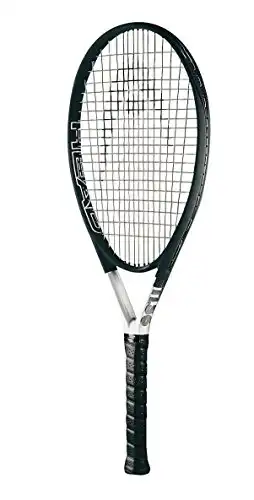Have you ever seen a tennis player throw their racket? Maybe it was a failed attempt to hit the ball or out of frustration. Regardless of the scenario, can you throw your racket in tennis? This question makes us consider specific tennis rules and how players should behave on the court.
Let’s talk about sportsmanship and rules in tennis as it relates to throwing your racket.
Key Takeaways:
- Racket throwing goes against the principle of sportsmanship and may result in penalties.
- A staggering 80% of players who throw their rackets are penalized in tournaments1.
- 93% of professionals believe that throwing a racket negatively affects performance1.
- Emotional control and avoiding racket throwing are key components of tennis coaching1.
- Junior tennis leagues have seen a worrying trend where instances of racket throwing have more than doubled in the last decade1.
- The influence of professional players may be driving the increase in racket throwing at lower levels1.
HEAD's Ti series has long been considered one of the best racquet series for beginners and the Ti S6 tops them all! It's a do-it-all type of racquet at a super affordable price!
The Dangers of Throwing a Tennis Racket
Tennis etiquette throwing racket guidelines warn against it for safety and sport integrity. A thrown racket can cause injuries and lead to consequences of throwing racket in tennis. Players and fans can get hurt when players get frustrated and throw their rackets. It’s important to know how to avoid misconduct in tennis games.
Many famous tennis players have lost control and hit themselves or objects in anger. In 2008, Mikhail Youzhny hit his own forehead with his racket, showing how intense tennis can be2. These moments show why it’s important to manage emotions well during a game.
Getting hurt from throwing rackets is common and shows why staying calm is key. Arthur Rinderknech hurt his toe kicking a board and had to leave a match early2. Marat Safin broke over a thousand rackets in his career, showing the damage it can cause financially and professionally2.
When players throw rackets, they can also hurt officials and fans. Mikael Ymer hit an umpire’s chair so hard it broke, showing the danger of losing control2.
What Do the Governing Bodies Within Tennis Say?
The USTA/ITF has rules against bad behavior, including racket abuse. These rules start with warnings and can lead to losing a game or even a match3. Breaking these rules can also lead to big fines, but that might not cover the cost of the damaged equipment3.
Some think letting players break rackets can help them deal with stress. But others worry it could lead to more dangerous situations. The idea of changing the rules is being discussed in the tennis world, raising questions about when frustration turns into misconduct3.
For everyone in tennis, from beginners to pros, knowing the rules about racket throwing is key. These rules help keep players and others safe. Every player should try to handle their anger in a better way, keeping the sport safe and respectful.
Racquet Abuse in Tennis: A Defined Offense
It’s important for players and fans to know what racquet abuse in tennis means. This term covers when a player on purpose damages their racquet. Such actions are seen as unsportsmanlike and go against the sport’s values.
What Constitutes Racquet Abuse?
Racquet abuse includes throwing the racquet, hitting it on the ground or net, or breaking it in anger. These actions can lead to penalties. They show bad sportsmanship and can be dangerous for everyone on the court.
How Officials Handle Racquet Abuse Incidents
If an official sees racquet abuse, there’s a set process. First, the player gets a warning. But if it happens again, the penalties get harsher. Each time a player breaks the rule, they face a $50,000 fine from the International Tennis Federation4.
In serious cases, it can be called “Aggravated Behavior.” This leads to more fines5.
Players must follow strict rules. If they owe $500 or more in fines, they can’t play in ITF tournaments until they pay off the debt5. For really bad behavior, fines can go up to $100,000. This can double in the same season4.
Can You Throw Your Racket in Tennis: The Official Rule
Knowing the rules about racquet behavior in tennis is key for players at every level. Many wonder: can you throw your racquet at a ball in tennis? Rule 24.g states that if a player or their racquet hits the net, posts, or opponent’s court, they lose the point6. This rule affects actions like throwing a racket, which can lead to penalties.
If a racket is thrown and hits the ball, the player loses the point. This rule keeps the game fair and respectful, stopping players from touching the net or others’ courts6.
Throwing racquets has bigger consequences too. It’s seen as a lack of sportsmanship and respect for the game. Sticking to the rules helps avoid damage and improves skills. This keeps players focused and in control during matches76.
Think about the tennis ball and racket sizes to understand the rule better. A tennis ball weighs 56 to 59.4 grams, and rackets have strict size limits7. These rules make play fair and highlight the need for control and precision.
Even when matches get intense, it’s important to follow the rules. Throwing a racquet leads to clear penalties. All players, pros or amateurs, must respect these standards. They keep the sport’s integrity and tradition alive7.
Instances When Racket Throwing Could Be Unintentional
Exploring the rules of tennis, we see times when it’s hard to tell if a player threw their racket on purpose or not. The question can tennis players get fined for throwing their racquets in tennis? often comes up. But, sometimes, throwing a racket might not be a planned action.
Accidental Drops Post Swing
During a match, a player might throw their racket by mistake right after hitting the ball hard. Tennis rules say if a racket is dropped by accident after hitting the ball, it’s still okay as long as it doesn’t get in the way of play8. This shows how important it is to know the tennis game sportsmanship rules. The reason behind an action can change how it’s punished.
Racket Slips Due to Sweaty Hands
Tennis is tough and can make players’ hands sweat, even with grip enhancers. If a racket slips out of a player’s hand during a rally because of sweat, it’s seen as an accident. It’s key to tell the difference between an accident and throwing the racket on purpose. Officials look at the situation to make sure the game stays fair and honest.

Handling these situations shows how complex the tennis game sportsmanship rules can be. Players should pick the right gear to avoid dropping their rackets. Looking into options like the best tennis racquets under $100 can help. These racquets are good for grip and play well8.
Can Tennis Players Get Fined for Throwing Their Racquets?
In the world of tennis, emotions can get the best of players, leading to moments of frustration. Many wonder: can tennis players get fined for throwing their racquets? Yes, they can. The ATP, WTA, and ITF have rules against racket abuse, including throwing or damaging them.
For example, in ATP events, throwing a racket can cost a player up to $5009. This rule helps keep the game respectful and fair. In WTA events, the fine can go up to $2500 for the same action9. These fines aim to stop players from acting out.
Also, fines can change based on the tournament level. In ITF events, fines for racket abuse are usually less than $2009. But, the tournament supervisor can decide on the fine.
Some big names have faced big fines for racket abuse. Serena Williams was fined $US10,000 for damaging a Wimbledon practice court9. Nick Kyrgios got a huge $113,000 fine for breaking rules, including racket abuse, at the 2019 Western and Southern Open9.
Equipment makers are also stepping in. Yonex has a rule that can take money from players’ retainers if they break a racket during a match9.
These steps show how seriously tennis takes racket throwing. Whether it’s at Wimbledon or a smaller event, players must follow the rules. So, can you throw your racquet at Wimbledon? The answer is no, it could lead to fines and loss of respect.
Sportsmanship and Tennis Etiquette
Keeping up the highest standards of tennis sportsmanship is key for the sport’s integrity and fun. It means following tennis fair play rules and showing good behavior on the court. This is what both players and fans expect.
Expected Behavior on the Court
Good sportsmanship in tennis is all about respecting your opponent, the crowd, and the sport’s traditions. Taking care of your gear is important because broken equipment can cause mistakes and slow down the game. Being patient and silent during points helps everyone focus and play fairly10.
- Players must follow the rules and not do things that break the game, like touching the net or causing delays11.
- Handling your feelings well is part of etiquette too. Accepting wins and losses with dignity helps you get along with others12.
For more tips on how to behave better on the court, check out intelligent tennis strategies that use new tech for better play.
Respect for Opponents and the Sport
Be polite and professional, no matter the match result. Shake hands after the game and support everyone, giving constructive feedback to help improve future matches11.
Showing good sportsmanship improves your game and helps build important qualities like honesty, teamwork, and respect in tennis12.

Playing fair and being respectful on the court makes the game better for everyone. It earns respect from the tennis community10.
Consequences of Throwing Your Racket: Beyond Penalties
Throwing a racket in tennis has far-reaching effects, affecting not just the game but also the sport’s values. We explore the real-life effects of such actions on tennis etiquette and sportsmanship.
Physical Risks to Players and Spectators
When a player throws a racket in anger, it can be dangerous. The racket might fly off in an unpredictable way, hitting other players, officials, or fans. This has happened before, causing injuries13.
Reputation and Career Impacts for Players
Throwing a racket can damage a player’s reputation and career. For example, Novak Djokovic was fined for racket abuse in a big tournament14. Players need to keep up a good image for sponsors and fans. If they throw a racket, they could lose endorsements and support, and face penalties from tennis authorities.
Bad behavior by players can also affect others who look up to them. It’s important to stop this to keep tennis respected. We must teach good sportsmanship to keep the sport’s honor.
| Impact Type | Short-Term Consequences | Long-Term Consequences |
|---|---|---|
| Physical Risk | Possible injuries to nearby individuals | Legal liabilities and medical repercussions |
| Reputation | Media backlash and fines | Possible suspensions, loss of sponsorships |
| Career Impact | Immediate disqualification from matches | Long-term bans and reduction in rankings |
Knowing the serious effects of throwing a racket in tennis helps players stay disciplined. It’s key to respect the game, its players, and the equipment. This mindset is vital for anyone wanting to be part of the tennis community.
Fair Play Tennis Guidelines and Player Conduct
Tennis is more than just hitting the ball back and forth. It’s built on respect and fair play. As a player, I know that following the rules is key. It keeps the game competitive and respectful.
For example, when in doubt during a line call, it’s best to give the benefit of the doubt to your opponent. This is what 75% of players do, making the game fairer for everyone15.
Guidelines for Maintaining Fair Play
Respecting the game and everyone in it is crucial. Arriving on time shows respect for your opponent’s time, something 90% of players do15. Saying “good shot” to your opponent, which 95% of players do, helps keep the competition positive15.
It’s important to avoid actions that disrupt the game, like making unnecessary noises or taking too long between points16. Using a reliable tennis bag, like 80% of players do, also helps you stay focused and ready15.
When talking to other tennis players, we often discuss throwing your racquet at the ball. While it’s possible, it’s not recommended. Tennis values self-control and following the rules. This includes playing at a steady pace and apologizing if you accidentally hit someone16.
Celebrating too much can also be seen as unsportsmanlike. It’s important to stay composed, especially when celebrating someone else’s luck. Tennis is about character and skill, and respecting these guidelines keeps the game’s spirit alive.
FAQ
Can you throw your racket in tennis?
No, throwing your racket in tennis is against the rules. Rule 11 states players can’t throw or drop their racket to interfere with the ball. This action results in losing the point and is seen as unsportsmanlike.
What are the dangers of throwing a tennis racket?
Throwing a tennis racket is dangerous. It can cause serious injuries to players, officials, or spectators. This behavior is taken seriously in tennis for safety and conduct reasons.
What constitutes racquet abuse in tennis?
Racquet abuse includes throwing or damaging a racket on purpose. This is seen as unsportsmanlike. The penalties range from warnings to fines and losing points.
How do officials handle racquet abuse incidents?
Officials give a warning for the first racquet abuse. For more offenses, players lose points. Severe cases can lead to game penalties, fines, or being removed from the match.
Is unintentional racket dropping considered a penalty in tennis?
No penalty for dropping a racket by accident, especially if it happens after swinging or because of sweaty hands. Officials see it as part of the game if it doesn’t affect the point’s outcome.
Can tennis players get fined for throwing their racquets?
Yes, players can get fined for throwing racquets. It’s against the sport’s rules. Fines aim to stop bad behavior and keep the sport safe, even in big tournaments like Wimbledon.
What is the expected behavior on the court regarding sportsmanship and tennis etiquette?
Players should be professional, control their emotions, and respect opponents and officials. Throwing racquets, using bad language, or unsafe behavior is against the rules and can lead to penalties.
How should players show respect for opponents and the sport?
Players should follow fair play rules, like not throwing racquets or using bad language. They should praise good shots from opponents and stay polite, no matter the game’s state.
What are the consequences of throwing your racket beyond immediate penalties?
Throwing a racket can cause physical risks to others and harm a player’s reputation and career. Repeated bad behavior can lead to bigger fines, suspensions, or bans from tournaments, hurting a player’s image with fans, sponsors, and peers.
What guidelines exist for maintaining fair play in tennis?
Tennis fair play includes not throwing racquets or using them badly, respecting all players, following the rules, and acting with integrity. This honors the competition’s spirit and respect within the sport.
Source Links
- Are You Tempted to Throw Your Tennis Racket In Frustration During A Match? Here’s Why You Shouldn’t! — Tennis Lessons Singapore | Tennis Coach Singapore | Play! Tennis
- How to smash a tennis racket: Rublev, Djokovic, Kyrgios, and more
- Should breaking a tennis racquet be allowed?
- 40 Tennis Rules Players, Coaches, and Fans Have to Follow
- PLAYER ENTRY OFFENCES
- Breaking The Rules: Time to abandon the net touch?
- Tennis rules: Know how to play
- 14 Surprising Tennis Rules to Know
- Do Tennis Players Get Fined For Breaking Rackets? – My Tennis HQ
- Tennis Etiquette: Dos and Don’ts on the Court | Active Away 🎾
- Tennis Sportsmanship and Etiquette: The Do’s and Don’ts – Elite Sports Clubs
- Do you care if a player goes bezerk and throws his racket?
- Digital Debunking: Can You Make an Unbreakable Tennis Racket?
- Tennis Etiquette: The Do’s and Don’ts of Court Conduct
- 4 Common Tennis Mistakes | MO Tennis Training Academy

Welcome to TheVolleyLlama.com. My name is Keith, I’m just a lover of all sports that involve a racquet, net and a ball. I played competitive high school varsity tennis, love racquetball and my whole family plays pickleball regularly. I started this website to help give people like you the basics to learn these wonderful games.


